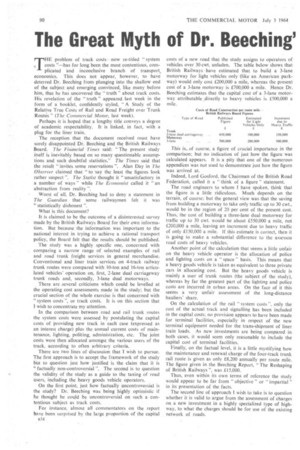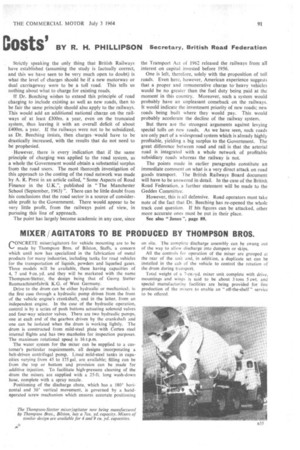The Great Myth of Dr. Beeching'
Page 92

Page 93

If you've noticed an error in this article please click here to report it so we can fix it.
costs' BY R. H. PHILLIPSON Secretary, British Road Federation THE problem of track costs— now re-titled "system , costs "—has for long been the most contentious, complicated and inconclusive branch of transport. economics. This does not appear, however, to have deterred Dr. Beeching from plunging into the shallow end of the subject and emerging convinced, like many before him, that he has uncovered the " truth " about track costs. His revelation of the "truth " appeared last week in the form of a booklet, confidently styled, "A Study of the Relative True Costs of Rail and Road Freight over Trunk Routs" (The Commercial Motor, last week).
Perhaps it is hoped that a lengthy title conveys a degree of academic respectability. It is linked, in fact, with a plug for the liner train.
The reception that the document received must have sorely disappointed Dr. Beeching and the British Railways Board. The Financial Times said: "The present study itself is inevitably based on so many questionable assumptions and such doubtful statistics." The Times said that the result "invites some reservations ". Alan Day in The Observer claimed that "to say the least the figures look rather suspect -. The Statist thought it "unsatisfactory in a number of ways " while The Economist called it "an abstraction from reality ".
Worst of all, Dr. Beeching had to deny a statement in The Guardian that some railwaymen felt it was "statistically dishonest ".
What is this document?
It is claimed to be the outcome of a disinterested survey made by the British Railways Board for their own information. But because the information was important to the national interest in trying to achieve a rational transport policy, the Board felt that the results should be published.
The study was a highly specific one, concerned with comparing a narrow range of selected examples of rail and road trunk freight services in general merchandise. Conventional and liner train services on 4-track railway trunk routes were compared with 10-ton and 16-ton articulated vehicles' operation on, first, 2-lane dual carriageway trunk roads and, secondly, 3-lane dual motorways.
There are ,several criticisms which could be levelled at the operating cost assessments made in the study; but the crucial section of the whole exercise is that concerned with "system costs ", or track costs. It is on this section that I wish to concentrate my attention.
In the comparison between road and rail trunk routes the system costs were assessed by postulating the capital costs of providing new track in each case (expressed as an interest charge) plus the annual current costs of maintenance, lighting, politing, administration, etc. The joint costs were then allocated amongst the various users of the track, according to often arbitrary criteria.
There are two lines of discussion that I wish to pursue. The first approach is to accept the framework of the study but to question just how justified is the claim that it is "factually non-controversial ". The second is to question the validity of the study as a guide to the taxing of road users, including the heavy goods vehicle operators.
On the first point, just how factually uncontroversial is the study? Dr. Beeching was being highly optimistic if he thought he conld be uncontroversial on such a contentious subject as track costs.
For instance, almost all commentators on the report have been surprised by the large proportion of the capital B34 costs of a new road that the study assigns to operators of vehicles over 30 cwt. unladen. The table below shows that British Railways have estimated that to build a 3-lane motorway for light vehicles only (like an American parkway) would only cost £200,000 a mile, whereas the present cost of a 3-lane motorway is £700,000 a mile. Hence Dr. Beeching estimates that the capital cost of a 3-lane motorway attributable directly to heavy vehicles is £500,000 a mile.
This is,. of course, a figure of crucial importance in the comparison; but no indication of just how the figure was calculated appears. It is a pity that one of the numerous appendices was not used to demonstrate just how the figure was arrived at.
Indeed, Lord Gosford, the Chairman of the British Road Federation, called it a think of a figure" statement.
The road engineers to whom I have spoken, think that the figure is a little ridiculous. Much depends on the terrain, of course: but the general view was that the saving from building a motorway to take only traffic up to 30 cwt., would be in the region of 20 per cent of the present cost. Thus, the cost of building a three-lane dual motorway for traffic up to 30 cwt. would be about £550,000 a mile, not £200,000 a mile, leaving an increment due to heavy traffic of only £150,000 a mile. If this estimate is correct, then it is going to make a substantial difference to the assesseo road costs of heavy vehicles.
Another point of the calculation that seems a little unfair on the heavy vehicle operator is the allocation of police and lighting costs on a "space" basis. This means that a heavy goods vehicle is taken as equivalent to three private cars in allocating cost. But the heavy goods vehicle is mainly a user of trunk routes (the subject of the study), whereas by far the greatest part of the lighting and police costs are incurred in urban areas. On the face of it this seems a very unfair assessment of the long-distance hauliers' share.
On the calculation of the rail "system costs ", only the cost of the actual track and signalling has been included in the capital costs; no provision appears to have been made for terminal facilities, especially in respect of the new terminal equipment needed for the trans-shipment of liner train loads. As new investments are being compared in both cases, it would seem only reasonable to include the capital cost of terminal facilities.
Finally, on the factual level, it is a little mystifying how the maintenance and renewal charge of the four-track trunk rail route is given as only £8,200 annually per route mile. The figure given in the Beeching Report, "The Reshaping of British Railways ", was £15,000.
Thus, even within its own terms of reference the study would appear to be far from " objective " or " impartial " in its presentation of the facts.
The second line of approach I wish to take is to question whether it is valid to argue from the assessment of charges on a new investment in a highly specialized type of highway, to what the charges should be for use of the existing network of roads. Strictly speaking the only thing that British Railways have established (assuming the study is factually correct, and this we have seen to be very much open to doubt) is what the level of charges should be if a new motorway or dual carriageway were to be a toll road. This tells us nothing about what to charge for existing roads.
If Dr. 'leeching wishes to extend this principle of road charging to include existing as well as new roads, then to be fair the same principle should also apply to the railways. This would add an additional national charge on the railways of at least £300m. a year, even on the truncated system, thus leaving it with an overall deficit of about £400m. a year. If the railways were not to be subsidized, as Dr. Beeching insists, then charges would have to be drastically increased, with the results that do not need to be prophesied.
However, there is every indication that if the same principle of charging was applied to the road system, as a whole the Government would obtain a substantial surplus from the road users. The most thorough investigation of this approach to the costing of the road network was made by A. R. Prest in an article called, "Some Aspects of Road Finance in the U.K.". published in "The Manchester School (September, 1963) ". There can be little doubt from his conclusions that the road sector is a source of considerable profit to the Government. There would appear to be very little profit, from the railways point of view, in pursuing this line of approach.
The point has largely become academic in any case, since the Transport Act of 1962 released the railways from all interest on capital invested before 1956.
One is left, therefore, solely with the proposition of toll roads. Even here, however, American experience suggests that a proper and remunerative charge to'heavy vehicles would be no greater than the fuel duty being paid at the moment in this country. Moreover, such a system would probably have an unpleasant comeback on the railways. It would indicate the investment priority of new roads; new roads being built where they would pay. This would probably accelerate the decline of the railway system.
But there are the strongest arguments against levying special tolls on new roads. As we have seen, such roads are only part of a widespread system which is already highly profitable, yielding a big surplus to the Government. The great difference between road and rail is that the arterial road is integrated with a whole network of profitable subsidiary roads whereas the railway is not.
The points made in earlier paragraphs constitute an immediate comment on what is a very direct attack on road goods transport. The British Railways Board document will have to be answered in detail. In the case of the British Road Federation, a further statement will be made to the Geddes Committee.
However, this is all defensive. Road operators must take note of the fact that Dr. Beeching has re-opened the whole track cost question. If his figures can be attacked, other more accurate ones must be put in their place.
See also "Janus", page 89.












































































































































